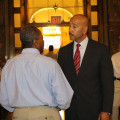The Bronx Is Up!
The real estate blog 6sqft.com recently posted about the residential boom occurring in the Bronx: “During the first six months of 2016, the Bronx [accounted] for nearly 32 percent of all permitted units, a major jump from its 11 percent average over the past four years.” Additionally, of all units under Mayor de Blasio’s affordable housing plan that began construction in the first half of this year, 43 percent were in the Bronx.
And New York Times columnist, Sam Roberts recently wrote a column taking note of the borough’s resugence.
“The borough, which lost one in five residents during the 1970s when it was afflicted by high crime and arson fires, has not only recouped its population loss but also appears to have surpassed its historic peak, according to new census projections.
“The borough’s population has been growing at an annual rate of one percent since 2010, the highest of any county in the state, thanks to an influx of immigrants. According to the Census Bureau, the Bronx’s population reached 1.455 million as of July 1, 2015, which is ahead of the pre-“Bronx is Burning” population height of 1970 at 1.472 million. Back then, factors such as high crime and arson led to an exodus where the population declined to 1.169 million. This “white flight” repeated itself from 2007 to 2014, when 30,000 more whites left the borough.
“But now, from 2014 to 2015, fewer than 1,000 whites left, while 13,000 foreign immigrants moved in, a three percent increase in the foreign-born population. Additionally, 50,000 more people are employed in the Bronx than five years ago.”
[Via the NY Times]Now ain’t that good news. It’s the culmination of the good work forged by Bronx Borough Presidents Ferrer, Carrion and Diaz as well as grassroots organizations such Banana Kelly, Mid Bronx Desperados, SEBCO, Citibank, SoBro, Community Preservation Corporation, NYC Housing Partnership, Mid Bronx Senior Council, Inc., Northwest Bronx Community and Clergy Coalition, WHEDCo, and many others that worked to save and restore the Bronx.
Reached by email for comment former Bronx Borough President Fernando Ferrer wrote, “The Bronx is as big or bigger and certainly better than it was in 1970. This forward progress is, I think, a result of the years of work and reinvestment that consciously focused on creating and preserving a large core of affordable housing, smart infrastructure spending and reducing crime.”
Mike Gill, a former banker and founding board member of the South Bronx Overall Economic Corporation (SoBro), credited the early and continuing hard work of SoBRO and other not-for-profits as well as the enlightened and risk-taking leadership of private-sector developers as Simone Development for the population growth in the Bronx — particularly the South Bronx. “But it is also a REVERSE reflection of the “end-of-cities” era that started in the ’50s and ’60s and kept propelling an out-migration of residents of all cities to the suburbs,” said Gill in an email.
Ferrer conceded that he doesn’t see gentrification as a threat because economic diversity is pretty much “baked into” Bronx communities. He also believes that Mayor de Blasio’s housing initiatives continue that economic diversity.
One of Ferrer’s successors, current Borough President Ruben Diaz, Jr. was heartened by the good news. “Our resurgence can be attributed to numerous factors, including historic increases in public safety, new investment, an influx of new immigrants and a growing business sector, among others,” said Diaz.
Diaz spoke of a change in the long-held perceptions about the Bronx, And he lauded “the hard work of so many who have fought for positive change in our borough, and that work is leading to new residents and new growth.”
Mike Gill believes that most of “today’s elected leaders and business leaders are very enlightened about the importance of affordable housing to assure that New York City [and the Bronx] continues as a major economic engine of the nation’s economy.”
“The offset to the natural market-driven forces of gentrification is aggressive public policies that encourage the private-sector development of affordable housing, said Gill.

















Follow Us